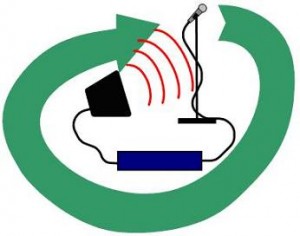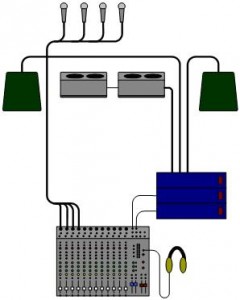What is feedback
Feedback occurs when a microphone (or other input like a guitar pickup) detects enough sound from a speaker that when the signal is run through the system it becomes louder than the first time and the mic picks up an even louder signal.

Note: feedback requires an acoustic input such as a mic (or guitar or turntable stylus). A CD or mp3 player will never be the source of feedback.
Solving Feedback
- Mic is too close to the speaker
- Mic is too far away from the source (person or instrument)
- Mic gain is too high (usually because the source is too far away)
- Mic is pointed at the speaker or sound is being bounced into the mic by a cupped hand over it or a reflecting surface like a wall.
If you double the distance from the speaker to the mic, you just cut the sound by 4.If you halve the distance from the mic to the source you just improved the gain before feedback by 4.
Note: Some microphones (and some speakers) are omni directional – these pick up just as well from the back as from the front.
EQ
It is possible to use a graphic equalizer or parametric EQ to notch out the problem frequencies for a particular mic location. Basically you put an EQ cut at the frequency or frequencies where the mic is feeding back.
Note: Applying EQ to reduce mic feedback should be the last resort. EQ changes should be minimized to avoid reduction in sound quality.
What is really happening?
Sound (especially feedback) is a bunch of sine waves. In an instantaneous system, a positive signal on the microphone would give a positive signal on the speaker which would give a positive signal on the microphone which…. would eventually run into some very bad limits.
Systems aren’t instantaneous: there is some delay in the amplification system which can usually be ignored and the speaker is some distance away from the microphone meaning the speed of sound will delay the signal. In most systems, the delay in the Unfortunately if this delay is an exact number of wavelengths, then the signal can feed back and grow. If there is enough loss in the circle, then the sound from the speaker is picked up by the microphone and amplified to a lower level than the original sound – these sounds will decay to nothing. Without loss (or too much gain) the sound picked up by the microphone is amplified to GREATER than the original and it will continue growing until something is changed or the system hits its limits.
Feedback Eliminators
Automatic feedback elimination can be done using Digital Signal Processors. Essentially they do some fancy analysis to figure out what sounds are feedback and they slap a notch filter on that frequency. While they are really cool to use and watch, they are expensive and still won’t solve all the problems. It is best to use conventional methods first.

